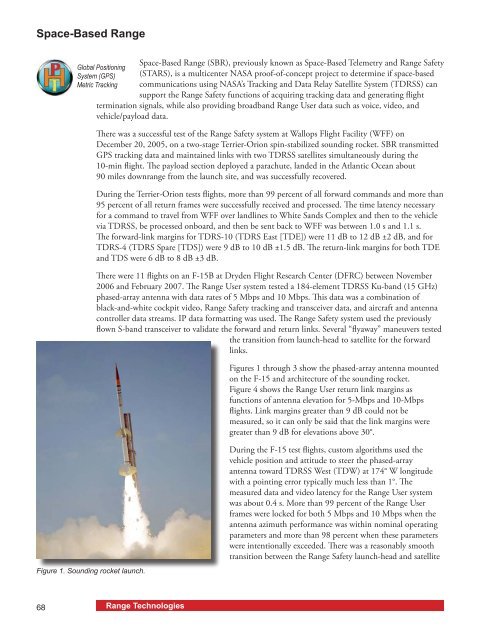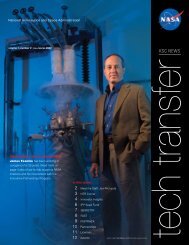2006-2007 - Kennedy Space Center Technology Transfer Office
2006-2007 - Kennedy Space Center Technology Transfer Office
2006-2007 - Kennedy Space Center Technology Transfer Office
- No tags were found...
You also want an ePaper? Increase the reach of your titles
YUMPU automatically turns print PDFs into web optimized ePapers that Google loves.
<strong>Space</strong>-Based Range<strong>Space</strong>-Based Range (SBR), previously known as <strong>Space</strong>-Based Telemetry and Range SafetyGlobal PositioningSystem (GPS) (STARS), is a multicenter NASA proof-of-concept project to determine if space-basedMetric Tracking communications using NASA’s Tracking and Data Relay Satellite System (TDRSS) cansupport the Range Safety functions of acquiring tracking data and generating flighttermination signals, while also providing broadband Range User data such as voice, video, andvehicle/payload data.Figure 1. Sounding rocket launch.There was a successful test of the Range Safety system at Wallops Flight Facility (WFF) onDecember 20, 2005, on a two-stage Terrier-Orion spin-stabilized sounding rocket. SBR transmittedGPS tracking data and maintained links with two TDRSS satellites simultaneously during the10‐min flight. The payload section deployed a parachute, landed in the Atlantic Ocean about90 miles downrange from the launch site, and was successfully recovered.During the Terrier-Orion tests flights, more than 99 percent of all forward commands and more than95 percent of all return frames were successfully received and processed. The time latency necessaryfor a command to travel from WFF over landlines to White Sands Complex and then to the vehiclevia TDRSS, be processed onboard, and then be sent back to WFF was between 1.0 s and 1.1 s.The forward-link margins for TDRS‐10 (TDRS East [TDE]) were 11 dB to 12 dB ±2 dB, and forTDRS‐4 (TDRS Spare [TDS]) were 9 dB to 10 dB ±1.5 dB. The return-link margins for both TDEand TDS were 6 dB to 8 dB ±3 dB.There were 11 flights on an F-15B at Dryden Flight Research <strong>Center</strong> (DFRC) between November<strong>2006</strong> and February <strong>2007</strong>. The Range User system tested a 184‐element TDRSS Ku-band (15 GHz)phased-array antenna with data rates of 5 Mbps and 10 Mbps. This data was a combination ofblack-and-white cockpit video, Range Safety tracking and transceiver data, and aircraft and antennacontroller data streams. IP data formatting was used. The Range Safety system used the previouslyflown S-band transceiver to validate the forward and return links. Several “flyaway” maneuvers testedthe transition from launch-head to satellite for the forwardlinks.Figures 1 through 3 show the phased-array antenna mountedon the F-15 and architecture of the sounding rocket.Figure 4 shows the Range User return link margins asfunctions of antenna elevation for 5‐Mbps and 10‐Mbpsflights. Link margins greater than 9 dB could not bemeasured, so it can only be said that the link margins weregreater than 9 dB for elevations above 30°.During the F-15 test flights, custom algorithms used thevehicle position and attitude to steer the phased-arrayantenna toward TDRSS West (TDW) at 174° W longitudewith a pointing error typically much less than 1°. Themeasured data and video latency for the Range User systemwas about 0.4 s. More than 99 percent of the Range Userframes were locked for both 5 Mbps and 10 Mbps when theantenna azimuth performance was within nominal operatingparameters and more than 98 percent when these parameterswere intentionally exceeded. There was a reasonably smoothtransition between the Range Safety launch-head and satellite68 Range Technologies













